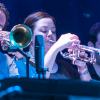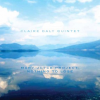Home » Jazz Articles » Album Review » Funk Shui NYC: Shark NATO on a Plane
Funk Shui NYC: Shark NATO on a Plane
As for the rhythms, they take their cue from present-day pop-rock, driving most numbers implacably forward behind the forceful volleys of drummer Peter Grant and percussionist Rex Benincasa. The other sections are no less decisive, enriching every number with an abundance of power and persuasion. Funk Shui's music may be exploratory, even unconventional, but it is most definitely jazz, nimbly performed by fifteen musicians who are by no means new to the game. Co-leaders Dave Morgan and Rob Susman wrote five of the album's ten numbers; the others were composed by George Harrison ("Blue Jay Way"), Cream ("I Feel Free"), Allen Toussaint ("Everything I Do Gonna Be Funky"), Jack Elliott ("What Barney?" a.k.a. the theme from TV's Barney Miller), DuBose Heyward and the Gershwin brothers (the album's lone standard, "Summertime").
Susman's "Shark NATO" leads the way, its Latin-cum-rock beat prefacing gritty solos by Morgan on baritone sax and Susman on trombone. Morgan's "July Groove / September Funk" is next, its slick 1970s-style funk and addictive melody giving way to earnest statements by trumpeter Bryan Davis and alto Charles Lee. "Barney Miller" is set to a hip-hop beat, while "Summertime" assumes a Latin rock persona and Susman's quirky "Into the Fourth Dimension" is a fluent showcase for trumpeter Seneca Black and the rhythm section. The second half of the session offers more of the same, starting with Morgan's angular "Professional Development" and proceeding through Susman's shuffling "Rock Bottom," the easygoing "Blue Jay Way," high-spirited "I Feel Free" (complete with unison hand-clapping) and loose-limbed "Everything I Do" (with Susman and fellow 'bone Scott Barnes holding a close-knit "conversation"). Other assertive solos are imparted courtesy of trumpeters Chris Anderson and Jordan Hirsch, tenors Stan Killian and John Isley, alto Chris Hemingway and bassist Dan Ashley.
Make no mistake, Shark NATO won't be everyone's cup of tea or blue-plate entree—especially those whose idea of a big band starts with names like Ellington, Basie, Herman, Rich or even Kenton. There is, on the other hand, no doubt that this is big-band jazz, superbly designed by first-class musicians. And once past the funk, rock and hip-hop substructure, it has much to offer those who choose to set aside any partiality and simply listen.
Track Listing
Shark NATO on a Plane; July Groove / September Funk; What Barney? (the Barney Miller theme); Summertime; Into the Fourth Dimension; Professional Development; Rock Bottom; Blue Jay Way; I Feel Free; Everything I Do Gonna Be Funky.
Personnel
Dave Morgan
bass, acousticRob Susman
saxophone, baritoneSeneca Black
trumpetChris Anderson
tromboneBryan Davis
pianoJordan Hirsch
trumpetChris Hemingway
saxophone, altoCharles Lee
saxophone, altoStan Killian
saxophone, tenorJohn Isley
saxophone, tenorScott Burrows
tromboneNoel Cohen
guitar, acousticDan Asher
bassRex Benincasa
percussionPeter Grant
drumsAlbum information
Title: Shark NATO on a Plane | Year Released: 2020 | Record Label: Zoho Music
< Previous
Rythme de Passage
Comments
About Dave Morgan
Instrument: Bass, acoustic
Related Articles | Concerts | Albums | Photos | Similar ToTags
For the Love of Jazz
 All About Jazz has been a pillar of jazz since 1995, championing it as an art form and, more importantly, supporting the musicians who create it. Our enduring commitment has made "AAJ" one of the most culturally important websites of its kind, read by hundreds of thousands of fans, musicians and industry figures every month.
All About Jazz has been a pillar of jazz since 1995, championing it as an art form and, more importantly, supporting the musicians who create it. Our enduring commitment has made "AAJ" one of the most culturally important websites of its kind, read by hundreds of thousands of fans, musicians and industry figures every month.


























